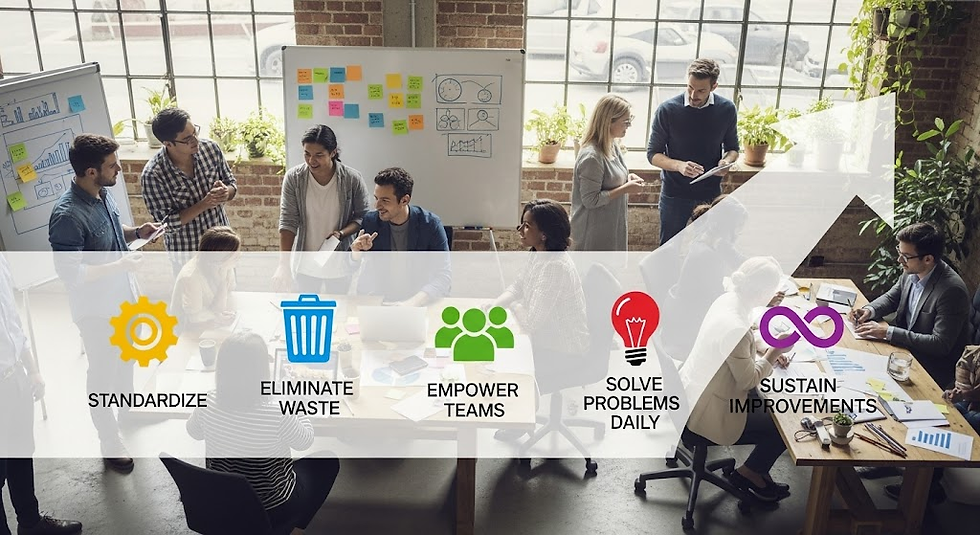Steps to Achieve Optimal Efficiency in Business Processes
- KPM SMARTBiz

- Jul 21
- 3 min read

We’ve all been there—juggling multiple tasks, trying to keep up with deadlines, and wondering if there’s a better way to make things run more smoothly.
Whether you’re a small business owner or part of a larger team, streamlining your processes isn’t just a nice-to-have; it’s essential for keeping things efficient, cutting costs, and delivering a better experience for your customers.
In this blog post, we’ll dive into simple, actionable steps you can take to improve your workflow, starting with where you’re at right now and moving toward strategies that can make a real difference.

Understanding Process Optimization
Before diving into the steps, it's essential to understand what process optimization entails.
Process optimization involves analyzing and improving existing business processes to enhance efficiency and effectiveness. Companies aim to streamline operations, minimize waste, and reduce redundancies.
According to a study by McKinsey, organizations that successfully optimize their processes can increase productivity by 20-30%.

Steps to Implement Process Optimization
1. Analyze Current Processes
The first step in achieving optimal efficiency is to conduct a thorough analysis of your current business processes. Map out existing workflows and identify bottlenecks or areas where delays frequently occur. Tools like flowcharts and process mapping software can help visualize complex processes.
For example, if you're in the manufacturing sector, analyze the production line for cycles that take longer than expected. Are there unnecessary steps that could be removed or combined?
2. Involve Your Team
Team involvement is critical for successful process optimization. Employees are often the first to identify inefficiencies. Conduct surveys, focus groups, or one-on-one interviews to gather insights from team members. They may have suggestions for improvement based on their daily experiences.
Moreover, encourage a culture where staff feels comfortable voicing their concerns regarding operational inefficiencies. Engaged employees are more likely to contribute innovative solutions. Implement their suggestions where feasible to foster an environment of continuous improvement.

3. What is the Process Optimization Strategy?
A process optimization strategy refers to the systematic approach undertaken to refine and enhance business operations. This could involve adopting new technologies, revising policies, or better resource allocation. The aim is to create a streamlined process that maximizes output while minimizing costs.
Key components of a strong process optimization strategy include:
Lean Principles: Emphasizing value creation while minimizing waste.
Automation: Utilizing technology to increase speed and reduce human error.
Benchmarking: Comparing performance against industry standards and best practices.
Implementing these vital strategies can play a critical role in your organization's success.
4. Set Clear Objectives
Once you have crafted your process optimization strategy, set clear, achievable objectives. SMART goals—specific, measurable, achievable, relevant, and time-bound—help provide a focus for the optimization effort.
For instance, if your goal is to reduce delivery times, a SMART objective might be "Decrease delivery times by 15% within six months." Clear objectives not only set a direction but also offer a means of measuring progress.
5. Implement Lean Strategies
Lean strategies are an essential component of process optimization. Adopt techniques to streamline processes, such as:
Value Stream Mapping: Analyzing the flow of materials and information.
5S Methodology: Sort, set in order, shine, standardize, and sustain to maintain an organized workspace.
Kaizen Events: Short-term projects focused on continuous improvement.
By implementing these lean practices, organizations can achieve significant improvements in efficiency and effectiveness.
6. Monitor Progress and Adjust
Process optimization is not a one-time effort but rather a continuous journey. After implementing changes, consistently monitor performance against the established objectives. Key Performance Indicators (KPIs) can help track improvements in efficiency, costs, and customer satisfaction.
Be prepared to make adjustments based on feedback and performance data. Flexibility is essential in optimizing processes; what works today may need refining tomorrow.
7. Foster a Culture of Continuous Improvement
To maintain optimal efficiency in business processes, it is crucial to foster a culture of continuous improvement. Encourage experimentation and innovation among your team, emphasizing that not every idea will lead to success, but lessons learned are valuable.
Celebrate small wins and use these achievements as motivation for further improvements. By creating an innovative environment, your organization will sustain high efficiency levels over time.
Final Thoughts
Achieving optimal efficiency in business processes is critical for long-term success. By understanding what process optimization encompasses and following these practical steps, you can streamline operations, enhance productivity, and foster a culture of continuous improvement.
For more information on effective process optimization strategies, consider exploring available resources or consulting with experts in the field. Embrace the journey toward efficiency today—your organization will thank you for it!





Comments